In this article, we will understand the practical sales techniques that can positively impact your business.
There are lots of sales techniques which salespeople across the globe use.
However, not many of them are practical.
Most of the popular sales techniques are only theoretical and not relevant in the present times.
As a result, people waste most of the time and money.
Although, with the right sales training company, you can save yourself from this damage.
Let’s learn the secret and practical sales techniques that the best sales trainers use.
#1 The Customer Decision Journey
Marketing has changed due to digital channels and informed consumers.
The old funnel model no longer works in today’s complex environment.
A more sophisticated approach is needed, considering all touchpoints before purchase.
Thus, here you need to understand the Consumer Decision Journey.
Intro to Consumer Decision Journey
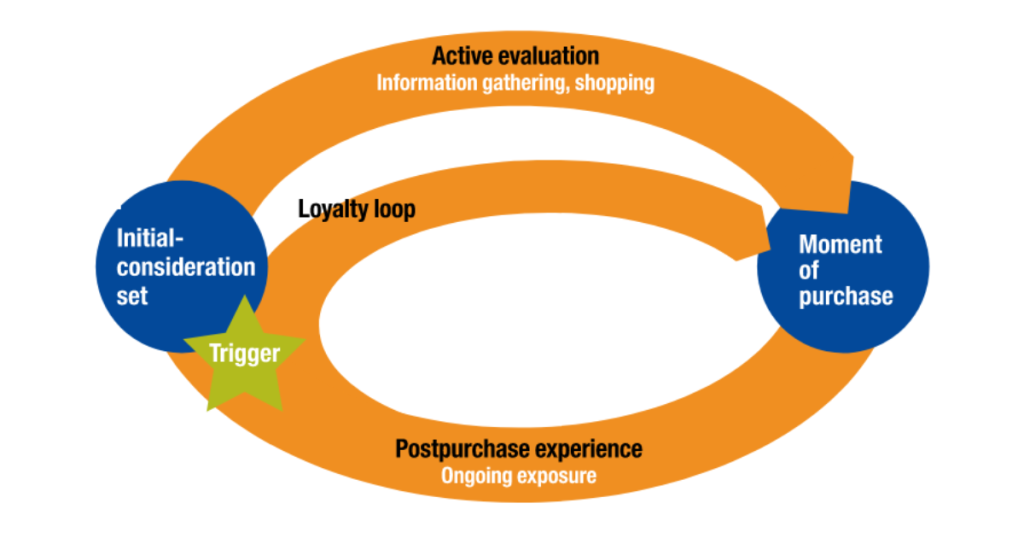
The consumer decision journey is a framework developed by McKinsey & Company that seeks to map out the various stages that consumers go through when making a purchase decision.
This journey is divided into four main stages
- Initial consideration,
- Active evaluation,
- Moment of purchase,
- Post-purchase experience.
Each stage is characterized by specific touchpoints that consumers have with a brand, as well as key factors that influence their decision-making process.
Stages of Consumer Decision Journey
First stage in Consumer Decision Journey
- The initial consideration stage is where consumers become aware of a problem or need and start considering different brands or products.
- It’s crucial for the brand to establish relevance and make a positive first impression.
- Advertising, word-of-mouth recommendations, and online reviews are some touchpoints at this stage.
Second Stage in Consumer Decision Journey
- The active evaluation stage is when consumers research and compare different options.
- Brands should provide the right information and make it easy for consumers to compare and contrast.
- Touchpoints at this stage could be product reviews, expert opinions, or trial offers.
Third Stage in Consumer Decision Journey
- The moment of purchase stage is known as the third stage.
- At this stage, consumers have narrowed down their options and are ready to make a purchase decision.
- This is where the brand needs to make it easy for the consumer to buy and provide a seamless purchasing experience.
- The touchpoints at this stage could include in-store displays, online checkout processes, or customer service.
Final Stage of the Consumer Decision Journey
- At this stage, consumers have made a purchase and are evaluating their experience with the product or service.
- This is where the brand needs to provide ongoing support and ensure that the consumer is satisfied with their purchase.
- The touchpoints at this stage include customer service, product usage guides, or loyalty programs.
Why use Consumer Decision Journey?
- The consumer decision journey framework helps salespeople and managers understand the consumer’s decision-making process and touchpoints with a brand.
- By mapping out stages and touchpoints, brands can identify areas of opportunity and develop targeted marketing strategies to influence consumer behavior.
- The framework is not limited to any specific industry or product category and is applicable to any market with diverse media options, internet connectivity, and abundant product choices.
- This includes emerging economies like India and China, where digital channels and well-informed consumers are transforming the marketing landscape.
Challenges of the Consumer Decision Journey Technique
One of the main challenges is that it requires a significant amount of data to be effective.
Brands need to gather data on consumer behaviour, preferences, and touchpoints at each stage of the journey.
This data needs to be analysed and synthesised to identify patterns and opportunities.
This can be a time-consuming and resource-intensive process, especially for small businesses or startups.
Another challenge is that the consumer decision journey is not a linear process.
Consumers can enter and exit the journey at any point, and the touchpoints can vary depending on the product category or market.
Thus, it requires brands to be flexible and adaptable.
#2 The Spin Sales Training Technique
Spin Selling is not only a theory but also a practical sales technique that has been tested and proven to be effective.
By incorporating Spin Selling into their sales training, businesses can develop practical sales techniques that are tailored to the needs and preferences of their customers.
One of the key benefits of Spin Selling is that it provides a practical framework for salespeople to engage with customers.
The four stages of Spin Selling provide a roadmap for salespeople to follow, enabling them to ask the right questions and uncover the customer’s needs and pain points.
At its core, Spin Selling is all about asking the right questions to uncover the customer’s needs, pain points, and priorities.
By doing so, salespeople can better understand their customers’ motivations and tailor their sales pitch accordingly.
But what makes Spin Selling so effective?
And how can businesses incorporate this methodology into their sales training?
Let’s take a closer look.
The Four Stages of Spin Selling
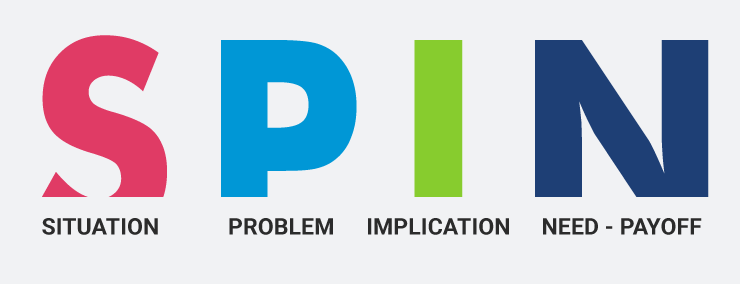
Spin Selling is based on four key stages that guide the sales process:
Situation Questions
- These are questions designed to gather information about the customer’s current situation, such as their current process, systems, and pain points.
- The goal is to identify potential areas where the salesperson can add value.
Problem Questions
- These questions aim to uncover the customer’s pain points and challenges.
- The salesperson should focus on asking open-ended questions that encourage the customer to provide detailed answers.
Implication Questions
- These questions are designed to help the customer understand the potential consequences of their pain points and challenges.
- By asking these questions, the salesperson can help the customer see the value in finding a solution.
Need-Payoff Questions
- These questions aim to help the customer envision the benefits of solving their problem.
- The salesperson should focus on asking questions that help the customer imagine a future where their pain points are resolved.
By following these four stages, salespeople can engage in a more consultative approach to selling that is focused on the customer’s needs and priorities.
Understand about the Spin Selling Technique in detail at: SPIN Sales Training: Techniques and Benefits
#3 Snap Selling
Snap Selling is a revolutionary approach to sales that emphasises building strong relationships with customers and providing practical solutions to their problems.
To succeed in this fast-paced business environment, sales professionals must be able to quickly connect with potential customers and effectively communicate the value of their products or services.
Major Components in Snap Selling
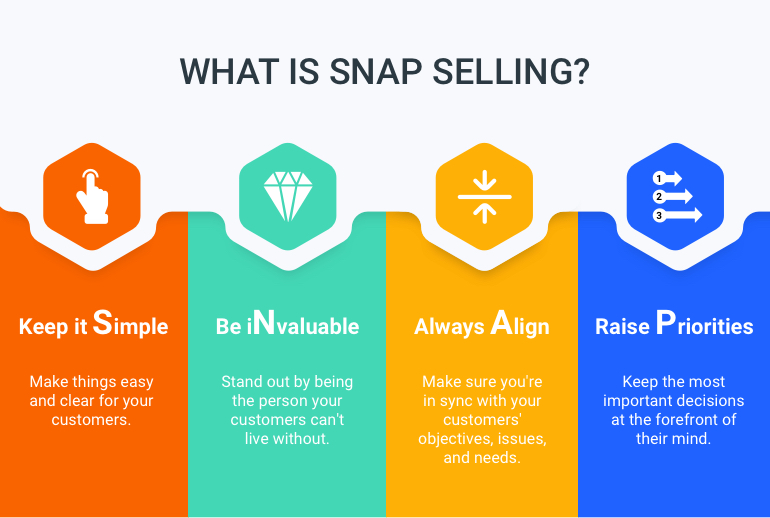
Keep it Simple
To avoid overwhelming “frazzled customers,” focus on providing the right information at the right time, rather than bombarding them with everything your solution can do. Limit options, keep content concise, set agendas and confirm next steps. Be mindful of each touchpoint in the sales process.
Be iNvaluable
Position yourself as a “trusted partner” who can help buyers solve their problems. Rather than persuading them, engage in intelligent conversations on equal footing, presenting data-driven insights and solutions. Find ways to add value in every interaction.
Align with buyers’ needs
Understand what matters to buyers and keep their priorities at the forefront of your sales cycle. Align your solution with their goals, pain points, and concerns. Don’t try to shift their priorities if they’re not ready.
Highlight priorities
Focus on the most important decisions and align your products, services, and messaging with the priorities that matter most to buyers. Use trigger events to shift their focus, present a vision of a better future, and emphasise business drivers and metrics.
In short, the key to success in Snap Selling is the ability to adapt to changing customer needs and preferences, while maintaining a strong focus on building relationships and providing practical solutions.
For more valuable information on Snap Selling, it’s best to consult an experienced sales trainer.
#4 The Challenger Sale Technique
The Challenger Sale is a practical sales technique designed to challenge customers’ assumptions and offer new insights.
It was introduced in a book The Challenger Sale: How To Take Control of the Customer Conversation by Brent Adamson and Matthew Dixon, experts in sales training and consultancy.
This approach has been proven effective and adopted by many leading sales organisations.
Overview of The Challenger Sale Technique
- It’s based on the concept that successful salespeople challenge their customers’ assumptions and provide new insights.
- The approach involves teaching salespeople how to engage customers in a way that challenges their assumptions and leads to a successful sale.
- The Challenger Sale is a practical and effective sales approach that has been adopted by many leading sales organisations.
- The goal of the technique is to help sales teams improve their performance and achieve better results.
The Practicality of the Challenger Sale
One of the key advantages of the Challenger Sale is its practicality.
The program is easy to learn and implement, providing a clear framework for engaging customers and closing deals.
The techniques taught in the Challenger Sale are based on years of research and experience and have been proven effective in a wide range of sales situations.
The Challenger Sale is not only a sales technique but a complete sales training program.
Hence, you might need to work with a sales training company.
Six steps of Challenger Sales Techniques
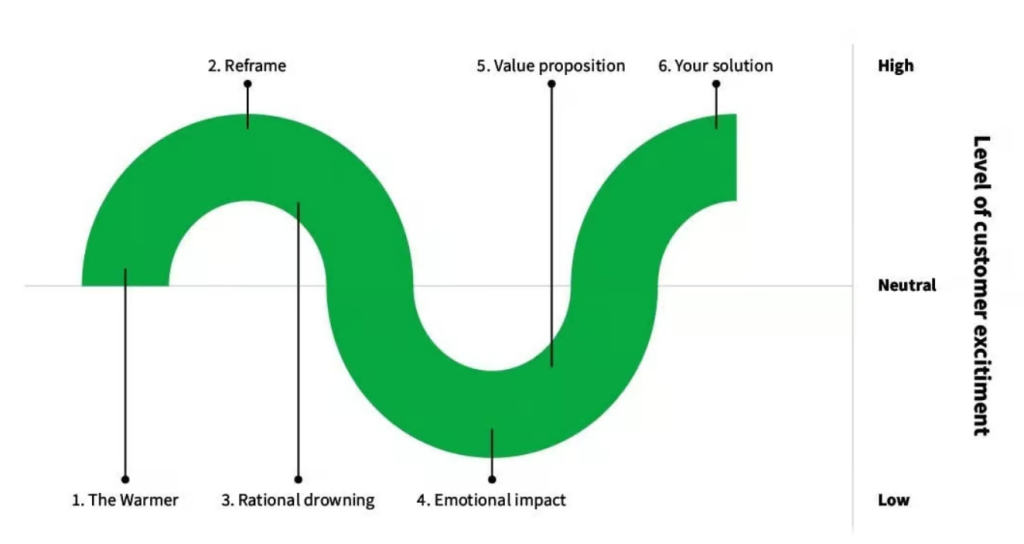
- The Warmer: Build credibility by showing understanding of the prospect’s needs and pain points.
- Reframe the conversation: Find the root of the prospect’s problems, challenge their assumptions, and present better solutions.
- Rational Drowning: Presenting your product as the answer, supported by data and insights to justify previous claims.
- Use emotions: Present relatable customer stories and show the prospect what will happen if they don’t change their outlook.
- Value proposition: Show the possibilities of a better future if the prospect chooses the new path.
- The New Way/Solution: Outlining a plan for implementing the solution effectively, explaining how it resolves the prospect’s issues and provides benefits.
Resources and Tools
- In addition to its training programs, the Challenger Sale also offers a range of resources and tools that can be used by sales teams to improve their performance.
- These resources include research reports, case studies, and best practices guides that provide insights into effective sales techniques and strategies.
- The company also offers software tools and platforms to help sales teams manage their sales activities more efficiently.
#5 Sandler Sales Method
The Sandler sales method is a step-by-step process that starts with building rapport and establishing trust with the potential customer.
Once trust is established, the salesperson moves on to identifying the prospect’s pain points and uncovering their needs.
Once the needs are identified, the salesperson moves on to developing a customised solution that addresses those needs.
The Sandler sales method emphasises the importance of involving the prospect in the solution development process, making it a collaborative effort rather than a one-sided pitch.
After the solution is developed, the salesperson moves on to closing the deal.
The Sandler sales method emphasises the importance of setting clear expectations and asking for a commitment from the prospect.
This helps to ensure that both parties are on the same page and there are no misunderstandings.
Common Practical Techniques in Sandler Sales Method
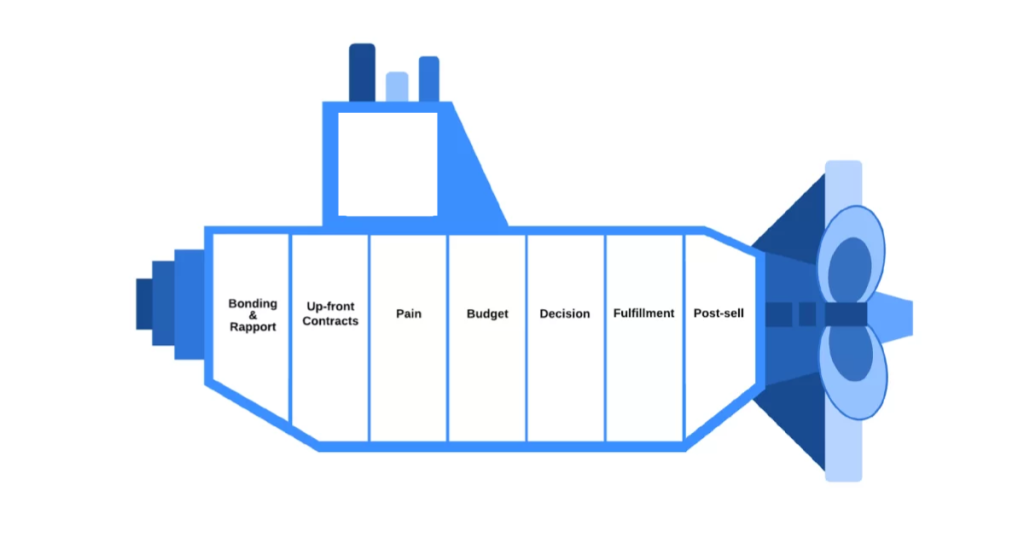
- Bonding and rapport building: Establish a connection with your prospect to encourage open communication.
- Up-front contracts: Set roles and expectations and create a comfortable environment for doing business.
- Pain: Identify your prospect’s problems and pain points by asking 2nd and 3rd level questions to move beyond surface-level pain.
- Budget: Discuss the prospect’s budget during the qualification phase to determine if they can afford your product or service.
- Decision: Find out how the prospect wants the buying process to go, including who, what, where, why, and how.
- Fulfilment: Propose your product or service as the solution to the prospect’s problem, keeping in mind everything you’ve learned during the qualifying process.
- Post-sell: Establish next steps to prevent the loss of the sale to the competition or buyer’s remorse.
#5 Consultative Selling
Intro to Consultative Selling
Consultative selling is a customer-focused approach to sales that emphasizes understanding the customer’s needs and providing personalized solutions that address their specific pain points.
Goal of Consultative Selling
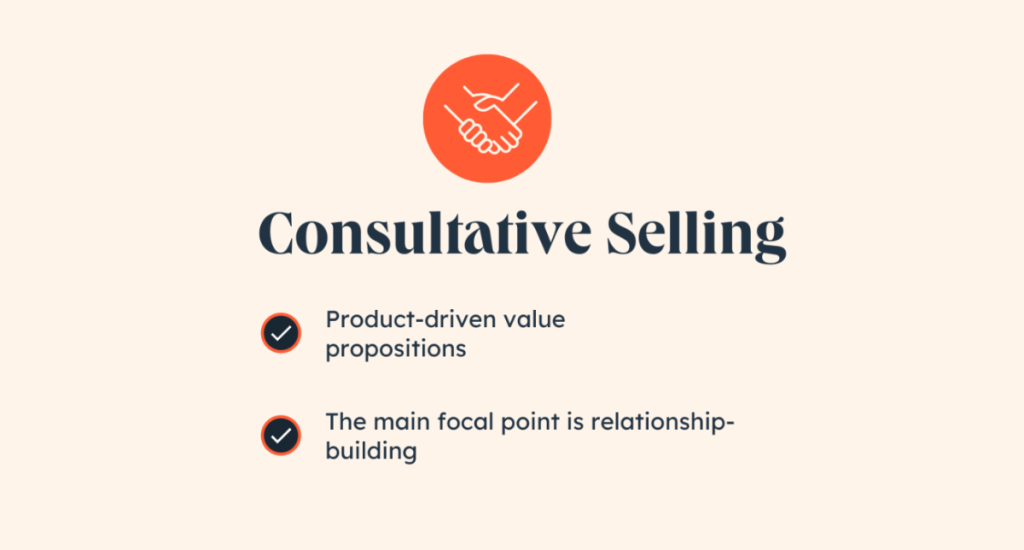
The goal of consultative selling is not just to make a sale but to build a long-term relationship with the customer by establishing trust and credibility.
Practical Sales Techniques in Consultative Selling
- One of the key components of consultative selling is active listening, where salespeople listen carefully to their customers to understand their needs and concerns.
- Consultative selling also involves asking the right questions that help the customer think critically about their business and identify areas where they may need help.
- By understanding the customer’s goals, salespeople can provide solutions that help them achieve those goals, which can lead to higher sales conversion rates.
- Providing value at every step of the sales process is crucial in consultative selling, as it helps to build trust and credibility with the customer.
Benefits of Consultative Selling Sales Technique
- Consultative selling can lead to long-term relationships with customers, which can result in repeat business and referrals.
- Salespeople who practise consultative selling need to have a deep understanding of the customer’s business, industry, and pain points.
- By tailoring their solutions to the customer’s specific needs, salespeople can increase the likelihood that the customer will see the value in the solution and make a purchase.
In short, Consultative selling requires a customer-centric mindset, where the salesperson is focused on solving the customer’s problems rather than just making a sale.
Importance of sales training company in implementing practical sales techniques
Sales training is crucial for any business that wants to achieve success in today’s competitive market.
Sales training companies play a vital role in providing practical sales techniques to salespeople to improve their performance, resulting in increased revenue and customer satisfaction.
Specialized Sales Training Programs
Sales training companies offer specialized training programs that are tailored to the needs of each business.
These programs focus on different areas of sales, including prospecting, lead generation, customer acquisition, negotiation, and closing deals.
They also provide customized training to suit the individual needs of each salesperson.
Benefits for Salespeople
One of the most significant benefits of sales training is that it helps salespeople to develop and refine their selling skills.
Effective sales techniques are essential to attract and retain customers, and sales training companies offer a range of techniques that are designed to achieve this goal.
These techniques include developing sales scripts, refining sales pitches, and building rapport with customers.
Boost in Sales Culture
Sales training companies also help businesses to create a sales culture.
A sales culture is one where every employee is aware of the importance of sales, and they are all committed to achieving the company’s sales objectives.
By creating a sales culture, businesses can improve communication, collaboration, and teamwork, leading to a more efficient and effective sales process.
Another essential aspect of sales training is that it helps salespeople to understand their customers better.
Understanding customer needs and wants is essential for successful sales.
Sales training companies provide salespeople with the tools and techniques to understand customer needs and preferences, enabling them to tailor their approach to each customer.
Update with Latest Technology
Finally, sales training companies help businesses to stay up-to-date with the latest trends and technologies in sales.
The sales landscape is continually evolving, and businesses need to keep up with the latest techniques and technologies to stay ahead of the competition.
Sales training companies provide businesses with the knowledge and skills needed to stay ahead of the game.
Conclusion
Mastering practical sales techniques is essential for businesses to succeed in today’s competitive market. There are a lot of practical sales techniques and the most important five that you must know and implement are mentioned in this article.



